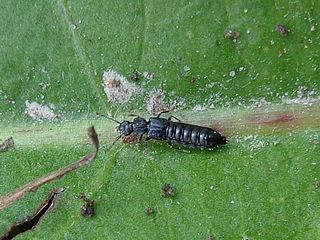
Ulex is a genus of flowering plants in the family Fabaceae. The genus comprises about 20 species of thorny evergreen shrubs in the subfamily Faboideae of the pea family Fabaceae. The species are native to parts of western Europe and northwest Africa, with the majority of species in Iberia.

Wasps of the cosmopolitan genus Polistes are the most familiar of the polistine wasps, and are the most common type of paper wasp in North America. It is also the single largest genus within the family Vespidae, with over 300 recognized species and subspecies. Their innate preferences for nest-building sites leads them to commonly build nests on human habitation, where they can be very unwelcome; although generally not aggressive, they can be provoked into defending their nests. All species are predatory, and they may consume large numbers of caterpillars, in which respect they are generally considered beneficial. The European paper wasp, Polistes dominula, was introduced into the US about 1981 and has quickly spread throughout most of the country, in most cases replacing native species within a few years. This species is very commonly mistaken for a yellow jacket, as it is black, strongly marked with yellow, and quite different from the native North American species of Polistes. The cuckoo wasp, Polistes sulcifer, is an obligate social parasite, whose only host is P. dominula. Polistes annularis, whose species name is Latin for "ringed", is also known for its distinctive red body color. Polistes metricus adults malaxate their insect prey by chewing them into a pulp, sucking out and ingesting the body fluids, then feeding the rest of the morsel to their larvae. The most widely distributed South American wasp species, Polistes versicolor, is particularly common in the southeastern Brazilian states. This social wasp is commonly referred to as the yellow paper wasp due to the distinct yellow bands found on its thorax and abdomen. Polistes wasps can be identified by their characteristic flight; their long legs dangle below their bodies, which are also more slender than a yellow jacket.

Agrypnus is a genus of click beetle.
Hypharpax is a genus of beetles in the family Carabidae, containing the following species:
Tilius is a genus of beetles in the family Carabidae, containing the following species:
Metius is a genus of beetles in the family Carabidae, containing the following species:
Metius subsericeus is a species of ground beetle in the subfamily Pterostichinae. It was described by Straneo in 1952.
Nyctimeniini is a tribe of longhorn beetles of the Lamiinae subfamily. It was described by Gressitt in 1951. It contains the single genus Nyctimenius.
Nyctimenius chiangi is a species of beetle in the family Cerambycidae. It was described by Huang, Liu and Chen in 2014. It is known from China.
Nyctimenius mamutensis is a species of beetle in the family Cerambycidae. It was described by Masao Hayashi in 1975. It is known from Borneo and Malaysia.
Nyctimenius ochraceovittatus is a species of beetle in the family Cerambycidae. It was described by Per Olof Christopher Aurivillius in 1922, originally under the genus Nyctimene. It is known from Borneo, Malaysia and the Philippines.
Nyctimenius palawanicus is a species of beetle in the family Cerambycidae. It was described by Per Olof Christopher Aurivillius in 1922. It is known from the Philippines.
Nyctimenius sabahensis is a species of beetle in the family Cerambycidae. It was described by Masao Hayashi in 1975. It is known from Borneo and Malaysia.
Nyctimenius tristis is a species of beetle in the family Cerambycidae. It was described by Johan Christian Fabricius in 1792,originally under the genus Saperda. It is known from Malaysia, Myanmar, India, Laos, the Philippines, Nepal, Thailand, China, Singapore, and Vietnam.
Nyctimenius varicornis is a species of beetle in the family Cerambycidae. It was described by Johan Christian Fabricius in 1801. It is known from Java, Cambodia, Singapore, Borneo, Sumatra, Malaysia, and Taiwan.
Diamimus is a genus of broad-nosed weevils in the beetle family Curculionidae. There is at least one described species in Diamimus, D. subsericeus.

Anotylus is a genus of spiny-legged rove beetles in the family Staphylinidae. There are at least 70 described species in Anotylus.

Dyscinetus is a genus of rice beetles in the family Scarabaeidae. There are at least 20 described species in Dyscinetus.






